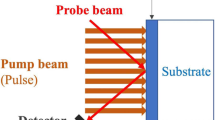Abstract
This paper describes a novel method for thickness measurement in conducting material by combining the measurement of the decaying induced eddy current and its associated apparent conductivity calculation. In conventional frequency domain NDE (Non-destructive Evaluation), the skin depth is the limiting factor due to the single frequency excitation. In contrast, with a pulsed excitation, the induced eddy currents decay with time and the decay of the eddy current consists of continuum of frequencies and hence the entire thickness of the conducting material could be investigated in a single shot. The time at which the decay of the eddy current is maximum is called diffusion time “tm” and the corresponding calculated value of apparent electrical conductivity “σmapp” both of which can be directly correlated to the thickness of the material. Since the induction of the eddy current and its associated secondary magnetic field measured by using suitable magnetic sensors [hz α (σ/t)3/2 for B-field and Vz α (σ3/2/t5/2) for an induction coil] is directly related to the conductivity of the materials, one can calculate the apparent conductivity σapp(t) as a function of decay time. Apparent conductivity calculations have been made for aluminum plates based on the thin conducting sheet model in which the applied magnetic field is uniform throughout the thickness. Subsequently, transient measurements have been performed with stacks of aluminum plates by using pickup coils in the form of an absolute as well as differential configuration. From this, it has been shown that the square root of the ratio of the maximum diffusion time, tm and the corresponding apparent conductivity, σmapp called as maximum diffusion depth, δm which is proportional to the plate thickness. The diffusion depth is a parameter derived from standard electromagnetic equations which is analogous to the skin depth in the frequency domain. In this work, induction coil sensors of both types have been used to measure the transients, and the other instruments such as transmitter, transmitter controller and data acquisition system used for this work are the same ones used for TDEM (time domain electro-magnetic) based geophysical applications.











Similar content being viewed by others
References
Venkatraman, B., Raj, B.: Chapter 1. In: Rao, B.P.C. (ed.) Practical Eddy Current Testing, pp. 1–19. Alpha Science, Oxford (2007)
Bowler, J.R., Harfield, N.: Evaluation of probe impedance due to thin skin eddy current interaction with surface cracks. IEEE Trans. Magn. 34(2), 515–523 (1998)
Smith, R., Hugo, G.: Deep corrosion and crack detection in aging aircrafts using transient eddy currents. In: Proceedings of the 6th Joint FAA/DoD/NASA Conference on Aging Aircraft, San Francisco
Sophian, A., Tian, G.Y., Taylor, D., Rudlin, J.: Design of a pulsed eddy current sensor for detection of defects in aircraft lap-joints. Sens. Actuators A 101(1–2), 92–98 (2002)
Tian, G.Y., Sophian, A., Taylor, D., Rudlin, J.: Multiple sensors on pulsed eddy-current detection for 3-D subsurface crack assessment. IEEE Sens. J. 5(1), 90–96 (2005)
He, Y., Luo, F., Pan, M., Weng, F., Hu, X., Gao, J., Liu, B.: Pulsed eddy current technique for defect detection in aircraft riveted structures. NDT E Int. 43, 176–181 (2010)
Tian, G.Y., Sophian, A.: Defect classification using a new feature for pulsed eddy current sensors. NDT E Int. 38(1), 77–82 (2005)
Krause, H.-J., Panaitov, G.I., Zhang, Y.: Conductivity tomography for non-destructive evaluation using pulsed eddy current with HTS SQUID magnetometer. IEEE Trans. Appl. Supercond. 13(2), 215–218 (2003)
Panaitov, G., Krause, H.-J., Zhang, Y.: Pulsed eddy current transient technique with HTS SQUID magnetometer for nondestructive evaluation. Physica C 372–376, 278–281 (2002)
Xu, Z., Wu, X., Li, J., Kang, Y.: Assessment of wall thinning in insulated ferromagnetic pipes using the time-to-peak of differential pulsed eddy-current testing signals. NDT E Int. 51, 24–29 (2012)
Xie, S., Chen, Z., Takagi, T., Uchimoto, T.: Quantitative non-destructive evaluation of wall thinning defect in double-layer pipe of nuclear power plants using pulsed ECT method. NDT E Int. 75, 87–95 (2015)
Kim, Y.J., Ahn, B., Lee, S., Shin, Y.: Thickness measurement of aluminum plates with a pulsed eddy current method. Mod. Phys. Lett. B 22(11), 911–915 (2008)
Kral, J., Smid, R., Ramos, H.M.G., Riberio, A.L.: Thickness measurements using transient eddy current NDE techniques. In: IEEE International Instrumentation and Measurement Technology Conference, Binjiang (2011)
Nagendran, R., Mohanty, I., Arasu, A.V.T., Baskaran, R.: Transient eddy current NDE system based on fluxgate sensor for the detection of defects in multilayered conducting material. J. Nondestruct. Eval. 37, 52 (2018). https://doi.org/10.1007/s10921-018-0511-3
Mohanty, I., Nagendran, R., Arasu, A.V.T., Baskaran, R., Mani, A.: Correlation of defect depth with diffusion time of eddy current for the defects in conducting materials using transient eddy current NDE. Meas. Sci. Technol. 29, 105601–105609 (2018)
Nabighian, M.N., Corbett, J.D.: Electromagnetic Methods in Applied Geophysics: Application, Parts A and B. Society of Exploration Geophysicists (2008). ISBN 978-1-56080-022-4 (v. 2)
Spies, B.R.: Depth of investigation in electromagnetic sounding methods. Geophysics 54(7), 872–888 (1989)
Acknowledgements
The authors would like to thank Shri R. Baskaran, Dr. N.V. Chandra Shekar, and Dr. Shaju K. Albert for their continuous support and encouragement in this work. The authors would also like to thank Shri R. Bharath for his support in the field throughout this work.
Author information
Authors and Affiliations
Corresponding author
Rights and permissions
About this article
Cite this article
Nagendran, R., Bisht, L. & Mohanty, I. A Novel Method for Thickness Measurement in Conducting Materials by Apparent Conductivity Calculation Through Transient Eddy Current NDE. J Nondestruct Eval 40, 30 (2021). https://doi.org/10.1007/s10921-021-00762-0
Received:
Accepted:
Published:
DOI: https://doi.org/10.1007/s10921-021-00762-0




